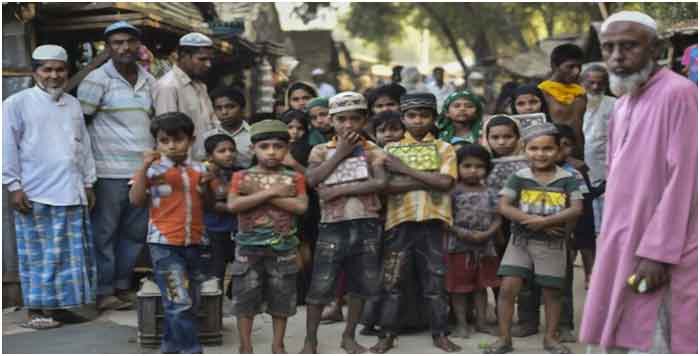
The Bangladesh government is planning to move hundreds of thousands of Rohingya refugees from Burma (Myanmar) into prison-like dwellings on the remote and geographically unstable silt island of Bhasan Char.
Around 900,000 Rohingya refugees are currently living in bamboo shelters and other makeshift accommodation in flood-prone valleys in Bangladesh, having fled murderous attacks by the Burmese military and Buddhist supremacist forces since August last year.
The refugees are from Burma’s north-western Rakhine state where they constitute an oppressed Muslim minority. Stripped of their citizenship rights in 1982, they have been subjected to systematic, state-sanctioned oppression and violence, including murder, rape, the destruction of whole villages and mass expulsions. A recent UN report estimates that almost 400 villages have been destroyed, and about three quarters of a million Rohingya have been forced to flee Burma.
The Burmese government brands the Rohingya, who have lived in Burma for decades, or even centuries, as “Bengalis” or “illegal immigrants” and has called for their expulsion to neighbouring Bangladesh. About 200,000 Rohingya refugees were already living in Bangladesh before the latest exodus.
The Rohingya have sought refuge in neighbouring Bangladesh in the hope that they would be sympathetically treated in the Muslim majority country. These hopes, however, have been cruelly dashed by successive governments in Dhaka.
Despite widespread public sympathy for the refugees, the Awami League government initially used the military to block the entry of the latest wave of refugees. When this failed the government forced the refugees into squalid, over-crowded settlements and camps that lack clean water, proper sanitary and health facilities and inadequate supplies of food.
The government now wants to shift them to Bhasan Char. The prison-like conditions, which the government is attempting to hide, were revealed in video footage published late last month by the British-based Guardian newspaper.
According to the newspaper, the Bangladesh government plans to send some 700,000 refugees to the island, which is situated at the mouth of the Meghna River, and only accessible by boat.
The refugees will be housed in tiny breeze-block concrete rooms 2m x 2.5m, with small, steel-barred windows. There will only be one bathroom per 25 housing units. The government wanted to begin moving the refugees in October but construction delays forced a postponement until early next year.
Nervous about domestic and international criticism, the government is attempting to hide information about the facilities and has placed the island under the tight control of the navy. Apart from registered construction workers, selected UN members and government officials, all access to the island and the building site is strictly prohibited. No official details or photos of the facilities have been released.
An anonymous human rights activist who shot the video told the Guardian that the yet-to-be-completed facility was “eerie” and said that the “hundreds of thousands of prison-like units [would create] an entire city of Rohingya… This feels more like a prison camp than a refugee haven.”
Bhasan Char, which is prone to severe monsoonal flooding and typhoons, is a three-hour boat ride from the mainland and under military control. The shape-shifting island emerged from the muddy waters of the Bay of Bengal less than two decades ago.
While the government has tried to justify its moves by claiming that the relocation is a temporary arrangement, the concrete structures at Bhasan Char make clear that the facilities are to be permanent. Refugees will only be able to leave the island if they agree to return to Burma or are accepted by a third country.
With national elections scheduled for late December, the Bangladesh opposition parties are attempting to exploit widespread popular concern about the treatment of the Rohingya refugees for their own political gain. Prime Minister Sheikh Hasina is waiting until the elections are over before releasing any details of its plan which will inevitably involve forcible relocations.
The US-based Human Rights Watch has warned that the government’s plans “essentially turn the island into a detention centre.” The agency’s Asia deputy director, Phil Robertson, told the Guardian: “Bangladesh’s plan to transform a desolate isle into a packed settlement of Rohingya housed in stark concrete residential blocks raises concerns for both freedom of movement and long-term sustainability.”
Spelling out some of the future dangers that the refugees will face, he added: “The housing blocks on display look sturdy, but how will they fare if a typhoon hits and floods the island? Will Dhaka ensure that anyone who agrees to move to the island will be allowed to leave and return freely?”
Last month the Bangladesh government attempted to forcibly repatriate 2,200 refugees to Burma but was forced to abandon these plans in the face of widespread protests. Mohamad Saddiq Hossain, a community leader from the Kutupalong refugee camp, told the Dhaka-based Telegraph on November 18: “We will not return without being given our rights as citizens.. . We would rather die here than be taken back there.”
While Rohingya continue to flee Burma, the refugees, rather than endure the miserable treatment meted out in Bangladesh, are prepared to risk their lives by attempting to sail to Malaysia, Indonesia and other countries. Over 200 lives have been lost in the Bay of Bengal since August last year.
The Guardian reported on December 5 that six boats carrying refugees from Burma had been washed ashore or stopped by authorities since October. Refugee boat sailings generally stop during June and August because of dangerous monsoon conditions. The fact that these sailings have resumed is another indication that the persecution of Rohingya by the Burmese government and its military and police continues unabated.
Originally published in WSWS.org

















































